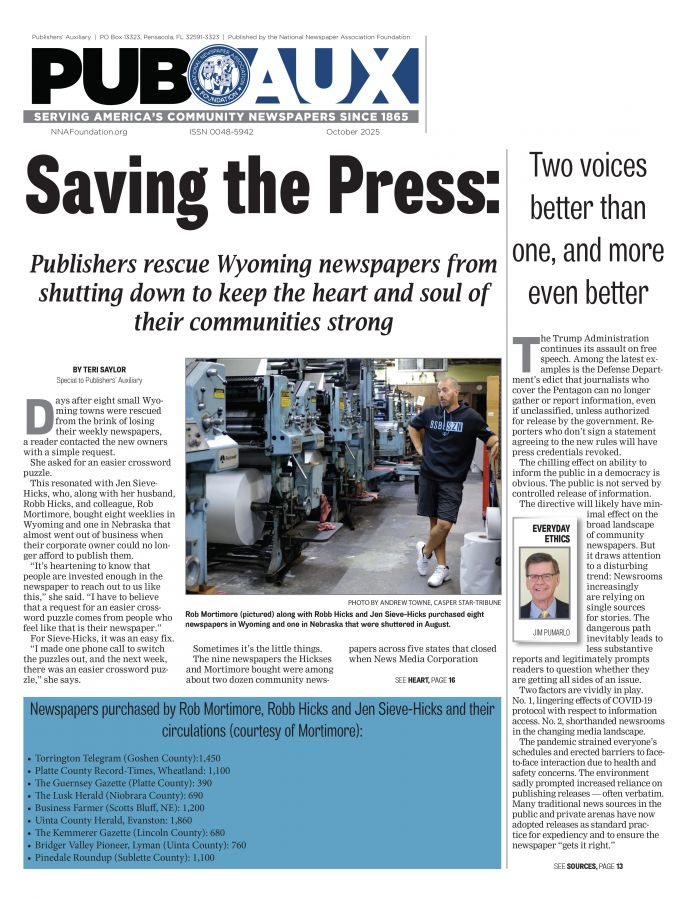Technology takes freedoms forward, law catches up
Aug 30, 2012
FOR IMMEDIATE RELEASE – PUBLISHABLE ANYTIME – 8/30-9/6, 2012
Inside the First Amendment
By Gene Policinski
First Amendment Center
As it made the quantum leap from parchment to paper through the electronic era to digital formats, First Amendment law on freedom of expression has lagged behind technology. Today, this delayed legal reaction is playing out once again with Twitter, Facebook and the World Wide Web.
The 45 words that protect our religious liberty, freedoms of speech and press, and the rights of assembly and petition, adopted in 1791, begin with the phrase “Congress shall make no law… .” And for more than a century, courts saw the First Amendment through that legal lens, as restricting only federal laws and actions.
But beginning in the 1920s the U.S. Supreme Court started, case-by-case, to apply the First Amendment to the states through the due-process clause of the 14th Amendment. With an eye toward current controversies, it’s worth considering the meandering path in which we have regulated, or decided not to regulate, new media and the technology of providing information, entertainment and communication.
We wasted little time as a nation trying to limit what editors could print, enacting in 1798 the Sedition Act, an attempt to squelch press criticism of Congress and the president. That early try at limiting free expression via the printing press quickly failed, and the act was allowed to expire within a few years.
Early laws and attempts to limit distribution of salacious images — from early “French postcards” and erotica, through movies, to videos on the Web — faced not only problems of legal definitions, but also the evolution of technology that kept content creators at least one step ahead of legislators-as-censors.
Pay-per-view movies and premium satellite channels have made attempts to close down “adult stores” seem quaint, and that was before the explosion of sex-saturated websites.
Movies became mass entertainment in the 1920s and prompted industry self-censorship in the 1930s to forestall congressional action. It was not until 1952 that the Supreme Court extended free-expression protection to motion pictures, in the landmark Burstyn, Inc. v. Wilson decision involving the film “The Miracle.”
Broadcasters labored until the 1980s under an unworkable FCC requirement called the Fairness Doctrine that purported to ensure all political voices would be heard on radio and television, but wound up having just the opposite effect. It was easier to keep voices off rather than accommodate them.
Congress has made several attempts, beginning in the 1990s, to ban or limit sexually themed content from the Web that it views as dangerous to children. Those laws largely have been seen by the courts as far too broad and restrictive of adult rights. The one part of those efforts that survives — Section 230 — protects Internet service providers and operations like Wikipedia from being sued successfully for defamatory posts and comments posted by others.
The newest battleground involves now-pervasive social media, where various First Amendment claims are being asserted by Facebook and Twitter or their users. From protection of posters’ identities, to the assertion that the “Like” button is free speech, to forced disclosure of private passwords and access to social networks, courts once again are taking up the challenge of applying old law to new circumstances.
Can courts force social-networking companies to disclose the names of those who post comments under pseudonyms, or will traditional protections for anonymous speech apply in this new venue? Twitter is resisting an attempt in New York to force disclosure.
Is “liking” a candidate on a Facebook page protected political expression — akin to wearing a T-shirt with a candidate’s slogan — or does it lack the basic meaning to rise from simple action to free speech? A federal district judge in Virginia says it falls short, but that decision has been appealed.
Does a tune become dangerous by virtue of being available on YouTube? The 6th U.S. Circuit Court of Appeals on Aug. 27 upheld the conviction of a Tennessee man who appeared in a YouTube video singing a menacing song aimed at a county judge who was handling his child-custody case.
Does Twitter and its 140-character message format qualify as protected speech? The American Civil Liberties Union, in a friend-of-the-court brief involving a New York state case and the Occupy movement, asserts that tweets are just that. It tells the court, “we have the right to speak freely on the Internet, safe in the knowledge that the government cannot obtain information about our communications or our private information unless law enforcement first satisfies First Amendment scrutiny.”
The path First Amendment law has taken evokes a timeworn saying: “Everything old is new again.”
Gene Policinski is senior vice president and executive director of the First Amendment Center, 1207 18th Ave. S., Nashville, Tenn., 37212. Web: www.firstamendmentcenter.org. E-mail: gpolicinski@fac.org.







